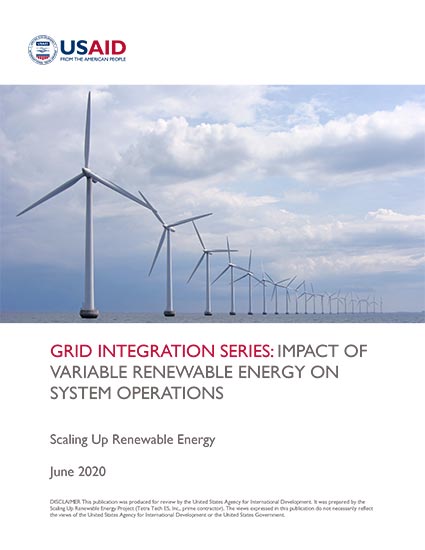- Energy Home
- How We Work
- Programs & Initiatives
- EmPOWERing Women and Girls
- Competitive Energy Procurement
- Auctions Toolkit
- Introduction
- Design
- Renewable Energy Integration
- Training
- Country Experience
- Resources
- Why Auctions?
- Designing RE Auctions
- Stages of Design
- Design Process
- Prequalification & Ceiling Prices
- Financial Guarantees & Penalties
- System-friendly Procurement
- Technology Selection
- Variable RE Forecasting
- Impact on System Operations
- System-friendly Procurement in Bangladesh
- Variable RE in Bangladesh
- Auctions Toolkit
- Toolkits
- Monitoring & Evaluation
- Resources
- Stories
Speeches Shim
Barriers to Grid Integration Series
Policymakers can improve a national power system’s operations and dramatically cut costs by increasing the power system’s flexibility to integrate large amounts of variable renewable energy.
As auction programs mature and the share of variable renewable energy (VRE) in power systems increases, many countries find that grid integration concerns become a real barrier to scaling up renewable energy. Policymakers’ objectives often evolve from low power generation costs to enhancing dispatchability and improving the value of renewable energy.
Power system flexibility is important for supporting VRE integration; this flexibility can be unlocked through improved system operation. The sources of operational flexibility include fully controllable conventional power units, renewable energy curtailment, energy storage plants with fully dispatchable storage, electric vehicle fleets, demand-side participation, and regional power import/export between zones. Other sources include smart network technologies and advanced network management practices that minimize bottlenecks and optimize transmission usage. The value of operational flexibility can be compensated via ancillary services, enabling the cost-efficient procurement of control reserve products.
Power Systems with Variable Renewable Energy
Power systems are highly dynamic and are affected by a range of quickly changing factors, as well as by season and year. Adding renewable energy, which is itself variable in nature, to an already dynamic power system can pose challenges. However, VRE can be effectively integrated into the grid if the power system has sufficient operational flexibility or the ability to respond to changes in electricity demand and generation.
Operating a System with a High Share of Variable Energy
The International Energy Agency (IEA) defines four phases of VRE integration, differentiated by the effects on power system operation resulting from increasing shares of annual VRE generation. As the effects of VRE become noticeable, system operators can modify their practices to integrate more VRE capacity and maintain smooth system operation.
Phase 1
In this initial phase, the share of VRE in annual electricity generation is under three percent, and VRE has no noticeable effect on the system.
Phase 2
In the second phase, the share of VRE in annual electricity generation is between three percent and 15 percent. In this phase, VRE has a noticeable effect but is manageable by upgrading some operational practices. Upgraded practices may include forecasting of VRE plant output to balance flexible resources along with that of electricity demand.
Phase 3
In the third phase, the share of VRE in annual electricity generation is between 15 percent and 25 percent. In this phase, VRE poses significant integration challenges (e.g., variability affects overall system operation). The power system must have the flexibility to respond to uncertainty and variability in the supply–demand balance within minutes to a few hours.
Phase 4
In this last phase, the share of VRE in annual electricity generation is at least 25 percent but typically still below 50 percent. VRE capacity can cover nearly 100 percent of demand at certain times. In this phase, VRE poses highly technical challenges for the stability of the power system’s operation, with a need to respond to variability in very short timescales (a few seconds or less).
Selected Country Experience
Colombia, India, Mexico, the Philippines, and Vietnam planned to add large-scale solar and wind energy generation. USAID used publicly available information to assess the system operations and power system readiness of these five countries to integrate VRE using the seven characteristics outlined below.
From the assessment of the five countries, USAID made a number of observations that can benefit other developing countries that are looking to improve operations and increase their power system’s flexibility to integrate large amounts of VRE.
Best Practices for System and Market Operation to Enable Power System Flexibility
The experiences of advanced national power systems with high shares of VRE provide a set of global best practices and seven characteristics that can be used to assess the maturity of a power system in its ability to respond to the challenges of VRE integration:
- Market protocols to access system flexibility;
- Clear dispatch rules for VRE;
- Grid code requirements for VRE;
- Long-term agreements for regional interconnection;
- Sufficient transmission capacity/planned investment;
- Ancillary services market products to reward flexibility; and
- VRE forecasting integrated into system operations.



Comment
Make a general inquiry or suggest an improvement.